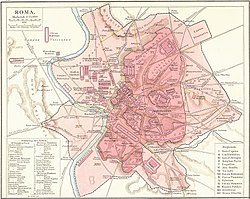Theatre of Marcellus

Theatre of Marcellus (above)
|
|
| Location | Regione IX Circus Flaminius |
|---|---|
| Built in | 13 BC |
| Built by/for | Julius Caesar Augustus Caesar / Marcus Marcellus |
| Type of structure | Roman theatre (structure) |
| Related | List of ancient monuments in Rome |
The Theatre of Marcellus (Latin: Theatrum Marcelli, Italian: Teatro di Marcello) is an ancient open-air theatre in Rome, Italy, built in the closing years of the Roman Republic. At the theatre, locals and visitors alike were able to watch performances of drama and song. Today its ancient edifice in the rione of Sant'Angelo, Rome, once again provides one of the city's many popular spectacles or tourist sites. Space for the theatre was cleared by Julius Caesar, who was murdered before its construction could begin; the theatre was so far advanced by 17 BC that part of the celebration of the ludi saeculares took place within the theatre; it was completed in 13 BC and formally inaugurated in 12 BC by Augustus.
The theatre was 111 m in diameter and was the largest and most important theatre in Ancient Rome; it could originally hold between 11,000 and 20,000 spectators. It was an impressive example of what was to become one of the most pervasive urban architectural forms of the Roman world. The theatre was built mainly of tuff, and concrete faced with stones in the pattern known as opus reticulatum, completely sheathed in white travertine. However, it is also the earliest dateable building in Rome to make use of fired Roman brick, then a new introduction from the Greek world.
The network of arches, corridors, tunnels and ramps that gave access to the interiors of such Roman theatres were normally ornamented with a screen of engaged columns in Greek orders: Doric at the base, Ionic in the middle. It is believed that Corinthian columns were used for the upper level but this is uncertain as the theatre was reconstructed in the Middle Ages, removing the top tier of seating and the columns.
...
Wikipedia

